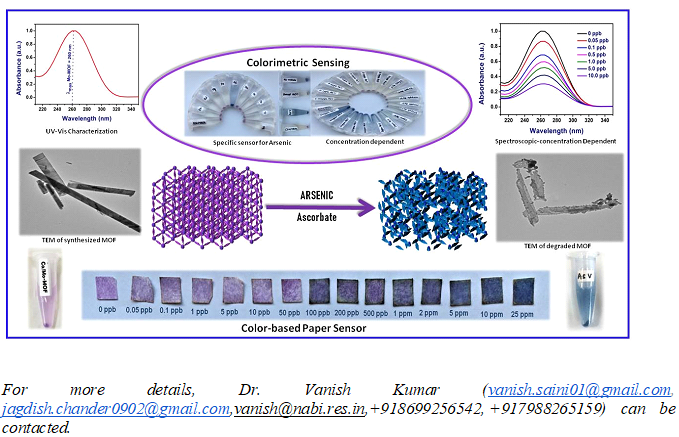Dr. Vanish Kumar, an Inspire Faculty Fellow, has developed an ultra-sensitive, easy-to-use sensor for detecting arsenic contamination in water and food samples in 15 minutes.

The developed sensor is highly sensitive, selective, involves a single step, and is applicable for various water and food samples. The developed sensor can be easily operated by a common man by just correlating the colour change (on sensor surface) with the standard labels.
The sensor developed by Dr. Kumar recipient of INSPIRE Faculty fellowship of the Department of
Science & Technology, GoI and currently positioned at the National Agri-Food Biotechnology Institute (NABI), Mohali, can be tested with three modes- spectroscopic measurements, colour intensity measurement with the help of colorimeter or mobile application, and with naked eyes.
Developed on mixed metal (cobalt/molybdenum) based metal-organic frameworks, it can detect a wide range of arsenic- from 0.05 ppb to 1000 ppm. In the case of paper and colorimetric sensors, the colour of the Metal-Organic Framework (MOF) changes from purple to blue after interaction with arsenic. The intensity of the blue colour increases with an increase in the concentration of arsenic.
It has been tested successfully for the fabrication of spectroscopic as well as paper-based tools for testing Arsenic in groundwater, rice extract, and plum juice. This research has been accepted for publication in ‘Chemical Engineering Journal’.
Identification of arsenic before consumption of water and food is imperative to protect common man from the possible health issues associated with arsenic. However, none of the existing methods of detection can be easily used by the common man.
The developed testing kit is 500 times more sensitive in comparison to the improved version of the Molybdenum-blue test, which is one of the most common (and traditional) tests used for the sensing of arsenic ions. It is also economical and simple as compared to the other commonly used analytical techniques such as Atomic Absorption Spectroscopy (AAS) and Inductively-coupled Plasma Mass Spectrometry (ICPMS), which required expensive set-ups, lengthy and complicated methodologies, skilled operators, complex machinery, and difficult sample preparations. Dr. Vanish Kumar’s team is the first to explore MOF for the sensing of arsenic ions on the basis of Mo-As interaction.
“The non-availability of sensitive and selective sensing method for arsenic ions is worrisome for our society. Considering this as a challenge, we started working on the development of a rapid and sensitive detection method for arsenic. The specific interaction between molybdenum and arsenic was known. So, we made material consisting of molybdenum and a catalyst (e.g., Co), which can give signals generated from molybdenum and arsenic interaction. After several attempts, we were able to develop a mixed metal MOF for the specific, one-step, and sensitive detection of arsenic ions,” said Dr. Kumar, explaining his research.
For more details, Dr. Vanish Kumar (vanish[dot]saini01[at]gmail[dot]com, jagdish[dot]chander0902[at]gmail[dot]com,vanish[at]nabi[dot]res[dot]in,+918699256542, +917988265159) can be contacted.






























